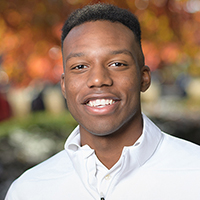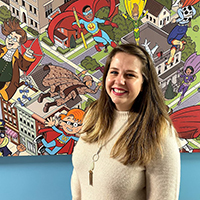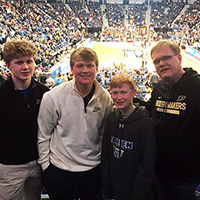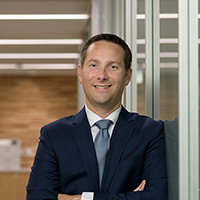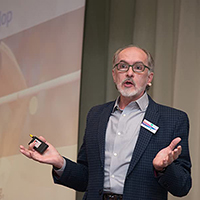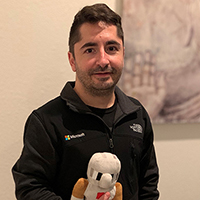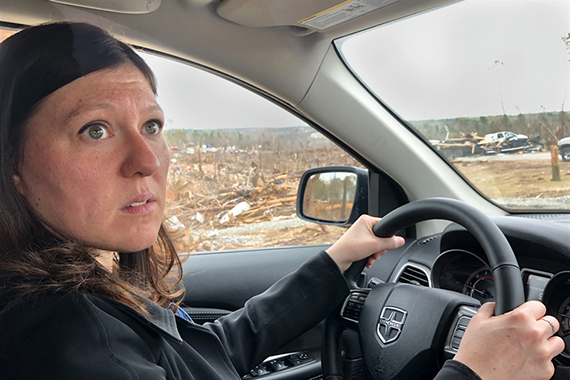 Kim Klockhow-McCain is a research scientist and coordinator of the Societal Applications Research Unit at the Cooperative Institute for Mesoscale Meteorological Studies (CIMMS) within the National Severe Storms Laboratory (NSLL). (Photo provided)
Kim Klockhow-McCain is a research scientist and coordinator of the Societal Applications Research Unit at the Cooperative Institute for Mesoscale Meteorological Studies (CIMMS) within the National Severe Storms Laboratory (NSLL). (Photo provided)
Putting Safety First
Alumna blends behavioral economics with meteorological research
Kim Klockow-McCain was just seven years old when her career plans began to take shape — in the form of a tornado.
While playing near her home in Naperville, Illinois, she witnessed a powerful twister decimate the neighboring suburb of Plainfield. The following year, another tornado in Plainfield chased Klockow-McCain and her family to the safety of their home.
“They were devastating events for the people around me,” she says. “I remember hearing all of the horrible stories about the people who died not knowing what was even happening. The world was just collapsing around them, and I wanted to be part of making sure that something like this never happened again.”
Today, as a research scientist and coordinator of the Societal Applications Research Unit at the Cooperative Institute for Mesoscale Meteorological Studies (CIMMS) within the National Severe Storms Laboratory (NSLL), Klockow-McCain is trying to do just that.
“I specialize in behavioral science focused on weather and climate risk, especially issues in the communication of forecast uncertainty and hazardous weather warnings,” she says. “I help to devise and execute strategic planning for social science research, assist program teams in identifying and including relevant research from the social, behavioral and economic sciences in their weather research programs, and coordinate our research programs with operational needs.
“Our goal is to understand the human behavior element and understand how people make choices in these very particular and difficult conditions and how it is that new technologies that are developed could inform decision-making.”
Klockow-McCain never imagined herself in such a role as an undergraduate at Purdue, where she earned bachelor’s degrees in synoptic meteorology and economics.
“I came into the meteorology program knowing that I really loved weather. They were very upfront with us about the limited job market for the field, however, so I brought in the economics part of my interests,” she says.
“The human aspect, how people make decisions, was just so fascinating to me. I didn't know how meteorology and economics could ever possibly be combined, but I decided I needed to have a competitive advantage, and where better to learn about competitive advantage than economics?”
After an internship chasing storms with the NSSL and working on research with a University of Oklahoma professor about the economic impact of tornadoes, Klockow-McCain knew she was on the right path and set her sights on graduate school.
Upon completing her master’s in professional meteorology at the University of Oklahoma, Klockow-McCain had pair of tempting job offers in the private sector, but turned them down to return to grad school for a PhD in Human/Hazards Geography.
“I had to look at myself and what has always motivated me, which is public safety,” she says. “Ever since I was a kid, I wanted to do something that was a bit more altruistic and not as focused on profit and the bottom line. It's not the perfect choice for everybody, but those are my values.”
Klockow-McCain began planning her next step while completing her doctorate, which mixed qualitative and quantitative methods from psychology and human geography to study risk perception and decision-making for severe weather.
“My focus started to shift a little bit from the basic science to how science can interface with policy,” she says. “Where can I situate myself to get my science heard? I thought, to whom do the agencies respond? They respond to Congress. Maybe if I go there I can learn some of the things that are needed to really interface with the agencies more fully and make my science more available.”
That brought her to Washington, D.C., as an AMS/UCAR Congressional Science Fellow for the American Association for the Advancement of Science, working in the offices of Oregon Senator Jeff Merkley.
Merkley was the chair of the subcommittee with jurisdiction of the National Flood Insurance Program, which was up for reauthorization. “That is one of the landmark pieces of legislation for how our country manages national hazards risk, and it interfaces with so many physical and social issues,” says Klockow-McCain. “I got to help craft legislation that became law through negotiations between different congressional offices.”
Her next stop was the National Oceanic & Atmospheric Administration (NOAA), where she worked to develop a strategy for integrating social and behavioral science research into meteorological research and applications.
Following three years as research scientist and policy advisor at NOAA, Klockow-McCain transitioned into her current role at CIMMS. During this period, her work caught the attention of bestselling author Michael Lewis, who was writing a book called The Fifth Risk that examined the presidential transition of the Trump administration.
“He was interested in the same proposition as me — how do people make choices in conditions of risk and uncertainty? He was also interested in the fact that I’m a storm chaser,” she says. “I had chased a weather event in Elk City, Oklahoma, that had particular importance for his narrative.”
In fact, the book’s final 20 pages prominently feature Klockow-McCain as one of the many unsung heroes who work in public service. “The little girl once terrified by the storm that was chasing her was now a woman chasing a storm,” Lewis wrote.
She is also doggedly pursuing the research goals of the Societal Applications Research Unit she now leads.
“When talking to all of the vested parties — emergency management agencies, broadcast meteorologists, forecasters and the public — you see places of great opportunity and gaps,” Klockow-McClain says. “Researchers can provide the best forecasting tools to our partners, but if people don’t use them, can’t use them and don’t want them for reasons we don’t understand — that helps no one. We have to understand how the public responds and how our partners interact.”

